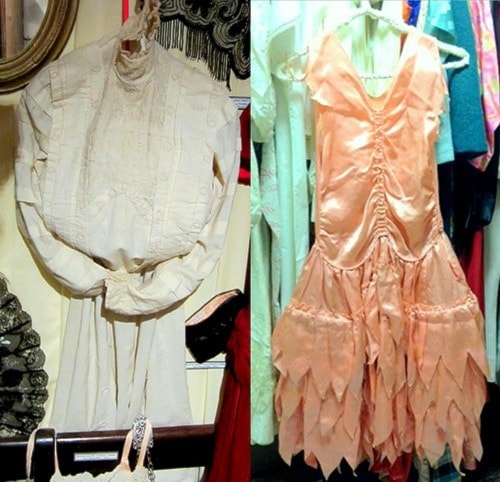The Sooke Region Museum’s artifact collection has numerous wedding dresses and accessories worn by Sooke brides since the early 1900s. The wedding dresses in our collection are all very different and represent multiple fashion eras and styles. Historically, white became a bridal statement when Queen Victoria wore it on February 10, 1840 for her marriage to her cousin Prince Albert of Saxe-Coburg. Initially, European nobility wore white as a mark of wealth because it was a difficult colour to keep. Even though other Royals had worn white at their nuptials, women envied the bridal fashion of Great Britain’s longest reigning monarch, especially during a time of such drastic social change. Since the mid-19th century, wearing white has become a tradition, but today it most often symbolizes goodness, innocence and purity rather than wealth.
Cream and ivory are popular alternatives to wearing stark white. On display in our women’s dressing room exhibit is a unique cream coloured bridal outfit from 1911. Alice Edna Gray (nee Milne) wore this two-piece cream ensemble on her June 10, 1911 wedding day. The separate blouse and skirt can trick the eye because, when worn together, the outfit appears to be a dress. The blouse has a high collar trimmed with lace and the front has large vertical lace panels. The back of the blouse has nine carved pearl-like buttons, which add a modest yet sophisticated touch. The full-length skirt is very simply made with five fabric panels and is decorated with ribbon. The seams are machine stitched and the outfit is speculated to have been made at home. Unfortunately, due to age, the fabric colour is beginning to darken. It is possible that Alice wore the blouse and skirt to other occasions too. It was not unusual for women of that time to re-use their wedding outfits in order to conserve funds.
While white is the most popular choice among brides, bright coloured wedding dresses have remained on trend for centuries. Our artifact collection has a variety of coloured wedding gowns including the pink satin dress worn by Florence Acreman (nee Muir) in her 1927 nuptials. Florence was the grand-niece of Michael Muir who was the son of John Muir Sr. Her sleeveless pink dress has coral undertones, hits below the knee and has three tiers of fabric on the skirt. The first tier of fabric has boning to give the skirt some structure and volume. It also has a dropped waist, gold stitching, a V-neck and ten alternating hook and button closures down the left side. This dress is very much representative of the roaring 20s fashion. Due to the dress’s fragile condition, it is currently stored safely in the museum’s textile collection. Pink wedding dresses typically signify femininity, purity, love and show off a flirtatious personality.
Also in our collection are sashes, veils, handkerchiefs, lingerie and numerous pairs of gloves and shoes worn by brides. For example, we have the undergarment set worn by Mrs. Phyllis Jessiman on her wedding day. The lightweight cream coloured silk bra and underwear set has lace detailing and hook and eye closures. The set is very delicate and does not have much structure, which could represent a relaxed and feminine style. In some cultures, what the bride wears under her dress is as important as the dress itself.
Tune in next month for part 2 of this wedding series to read about the unique wedding gifts in our artifact collection.
Brianna Shambrook, Collections and Exhibits ManagerSooke Region Museum
